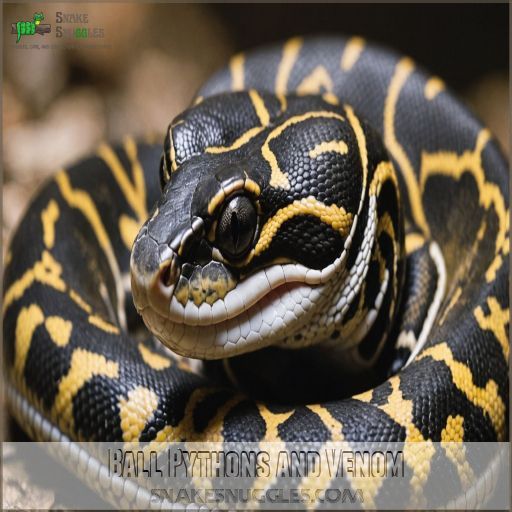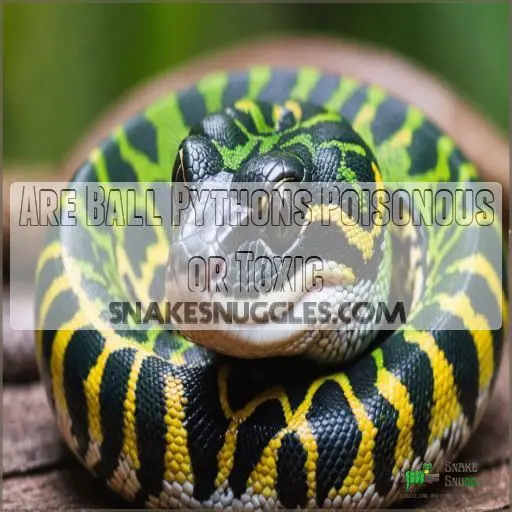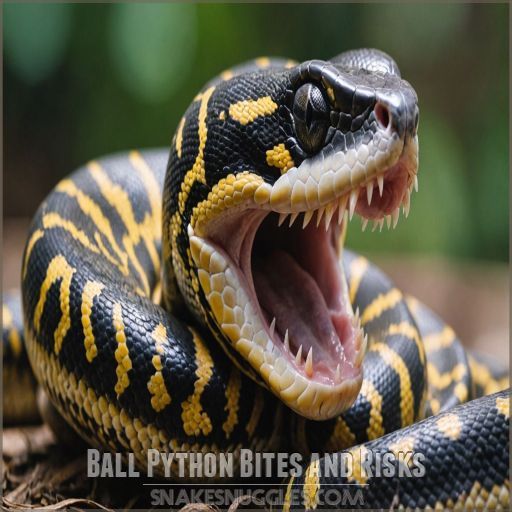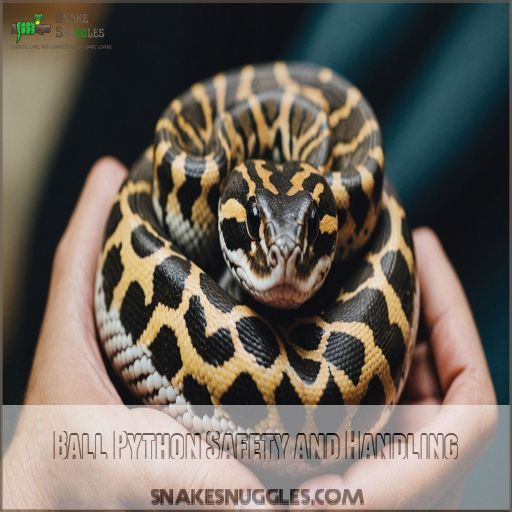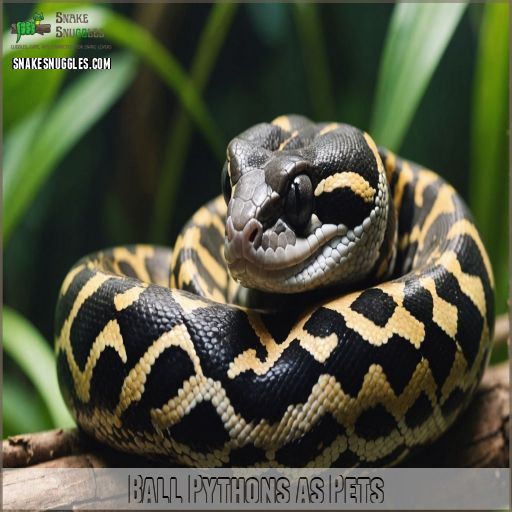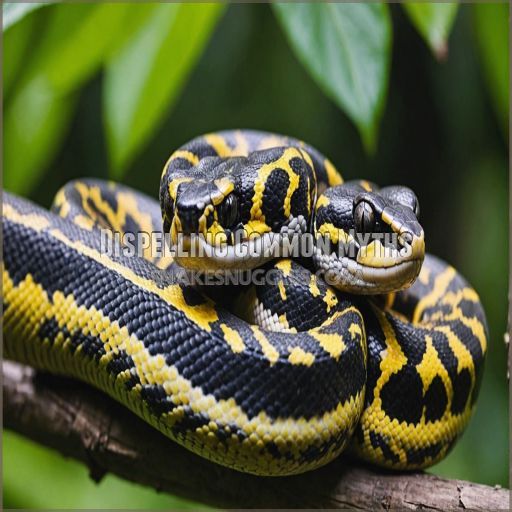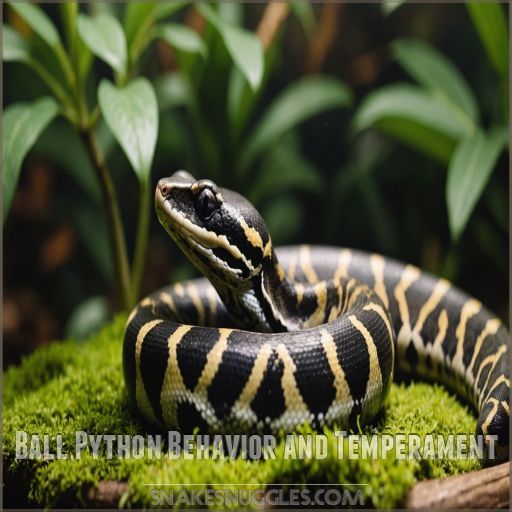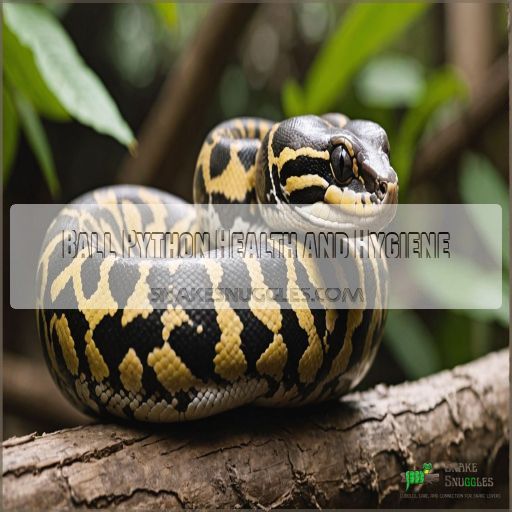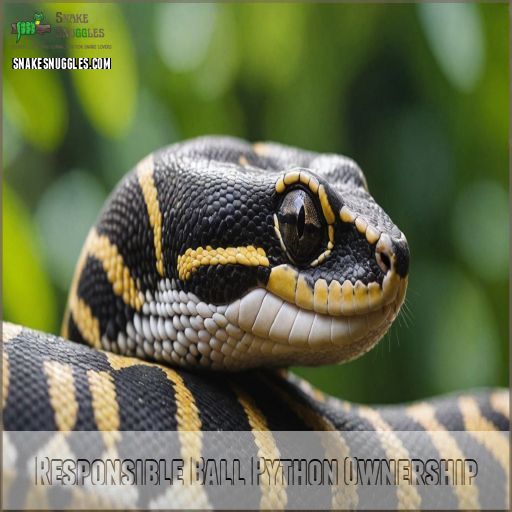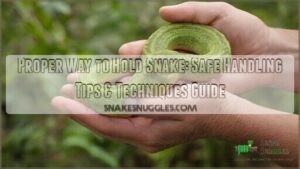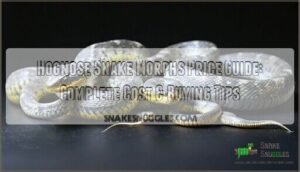This site is supported by our readers. We may earn a commission, at no cost to you, if you purchase through links.
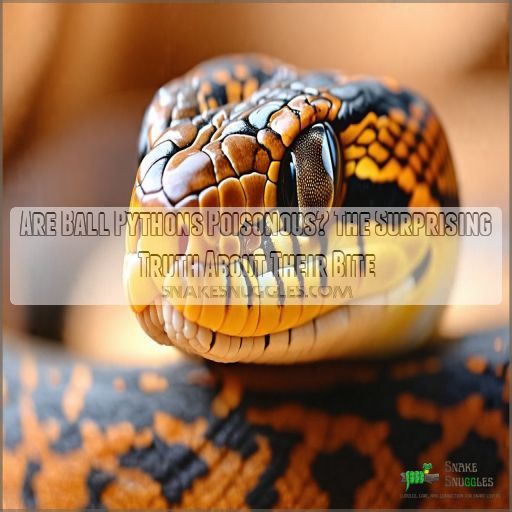 Wondering if ball pythons are poisonous? Rest easy—they’re not. These snakes don’t have venom glands or fangs.
Wondering if ball pythons are poisonous? Rest easy—they’re not. These snakes don’t have venom glands or fangs.
Instead, they use their muscles to give prey a good squeeze. If one bites you, specifically using their muscles to give prey a good squeeze. If one bites you, it won’t be toxic, but you might feel a sting and there’s a small chance of infection.
Keep an eye out for redness or swelling, and clean the area thoroughly. It’s like getting a paper cut—annoying, but hardly deadly.
Knowing how ball pythons work helps you feel secure, especially if you’re thinking about one as a pet, and learning more about ball python bites Ball Python Bite Characteristics and safe handling and care
. Stick around to learn more.
Table Of Contents
- Key Takeaways
- Ball Pythons and Venom
- Are Ball Pythons Poisonous or Toxic
- Ball Python Bites and Risks
- Ball Python Safety and Handling
- Ball Pythons as Pets
- Dispelling Common Myths
- Ball Python Behavior and Temperament
- Ball Python Health and Hygiene
- Responsible Ball Python Ownership
- Frequently Asked Questions (FAQs)
- Are ball pythons venomous?
- Are ball pythons good pets?
- Are ball python bites dangerous?
- Are ball pythons irritable?
- What happens if a ball python bites you?
- Is it safe to touch a ball python?
- Are ball pythons safe pets?
- Is a ball python a friendly snake?
- How big do ball pythons typically grow?
- What do ball pythons eat in the wild?
- Are ball pythons legal to own as pets?
- How often do ball pythons shed their skin?
- Can ball pythons recognize their owners?
- Conclusion
Key Takeaways
- You can breathe easy – ball pythons aren’t poisonous or venomous. They’re more likely to give you a friendly squeeze than a toxic bite.
- If a ball python does bite you, it’s more like a paper cut than a deadly encounter. Clean the wound and keep an eye out for infection, and you’ll be fine.
- These snakes make great pets for beginners. They’re low-maintenance, docile, and about as dangerous as a grumpy cat – just with scales instead of fur.
- Handling your ball python safely is key to understanding their behavior and building trust
. Move slowly, support its body, and avoid quick movements. It’s like a dance, but with a partner who’s always in the mood for a nap.
Ball Pythons and Venom
You might worry about a ball python’s bite, wondering if there’s venom involved, but rest easy—these snakes don’t produce venom at all.
They’re basically the gentle giants of the snake world, using a friendly squeeze rather than venom to catch their meals.
They rely on this friendly squeeze to catch their prey, rather than using venom like some other snakes.
How Snakes Produce Venom
Wondering how snakes produce venom? It arises from modified salivary glands, evolving over millennia, enhancing their venom function.
Snakes employ a venom delivery system via hollow fangs, acting like mini hypodermic needles (Source).
While exploring venom gland anatomy, you might chuckle and think, "Who knew ancient saliva led to such an elaborate defensive behavior?" Curious, right?
Why Ball Pythons Are Not Venomous
Ball pythons aren’t venomous due to their unique adaptations.
Lacking venom delivery systems, these snakes evolved to constrict prey instead of using fangs to inject venom. It’s like they skipped the snake evolution seminar on venom and chose a different path!
With non-venomous adaptations, they become great, safe companions for responsible pet ownership.
Just watch for their warning signs! They make excellent pets due to their unique adaptations.
Misconceptions About Ball Python Venom
You might think ball pythons have venom glands and toxic saliva, but that’s a venom myth.
These charming creatures lack venom and fangs, so don’t worry about their bite turning you into a superhero.
While they can’t poison, their bites may still sting and invite bacteria for tea.
Remember, a bite can be an inconvenient houseguest.
Are Ball Pythons Poisonous or Toxic
You might be wondering if your ball python is poisonous, but here’s the good news: they aren’t.
While their bite isn’t toxic, getting surprised by one sure can keep you guessing!
The Difference Between Poisonous and Venomous
Ah, the age-old question – are ball pythons poisonous or venomous? Let’s clear the air, shall we?
Poisonous means the toxin is ingested, while venomous means it’s injected through a bite or sting.
Thankfully, ball pythons are neither! They’re simply constrictor snakes that use their strength, not venom, to subdue prey.
So you can rest easy, these gentle giants won’t be biting you anytime soon (Source).
Ball Pythons and Toxicity
Understanding the difference between poisonous and venomous snakes sets the stage for relief—ball pythons aren’t toxic either.
While they can give a quick, painful nibble, they’re non-venomous.
These snakes are like that friend who talks a big game but means no harm.
So, rest easy knowing ball python bite risks are more about infection than toxins, making it more of a quick, painful nibble, similar to those from their larger cousins, the Blood Python’s anxious nature
.
How Ball Pythons Catch Prey
Ball pythons have a unique approach to catching prey.
Using their heat-sensing pits—nature’s infrared goggles—they detect unsuspecting animals even in the dark.
With a swift ambush, they latch on with precise jaw mechanics, followed by a constricting kill.
This tactic helps them efficiently secure a meal without the need for venom, perfect for these peaceful pythons.
Ball Python Bites and Risks
So, a ball python nips you—what’s the real deal?
While their bite isn’t venomous, you’ll definitely want to know how to handle it and when to seek medical help to keep things from getting too wild.
What Happens if a Ball Python Bites You
If a ball python bites you, don’t panic.
Although their bite isn’t venomous, there’s an infection risk due to bacteria. Clean the wound promptly with soap and water. Seek advice from a doctor for treatment options.
For first aid, apply a bandage if needed.
To prevent bites, handle your snake gently; be its calm, reassuring presence.
Symptoms of a Ball Python Bite
You might find yourself with puncture marks and some swelling if a ball python decides to take a nibble.
Though non-venomous, their bite can be a pain—not like stepping on a LEGO, but still not a walk in the park.
Pay attention to symptoms like redness or tingling, and keep an eye out for any infection risk.
How to Treat a Ball Python Bite
A ball python bite mightn’t be venomous, but it can still bite like the dickens, causing an infection risk.
Here’s how you treat it:
- Wash with warm water and soap.
- Cleanse with antiseptic.
- Consider wrapping with a bandage.
- Seek medical attention if the bite severity demands it.
Stay informed, stay safe!
Ball Python Safety and Handling
Handling your ball python the right way, especially in separate enclosures, can keep you both safe and happy avoiding cohabitation stress
. Follow some simple tips to avoid getting bitten and make the most of your slithery friend.
Safe Handling Techniques for Ball Pythons
Approaching with care, like a snake charmer, makes for smooth ball python handling. Stay in sight and avoid quick movements to prevent stress signs.
Create a safe environment by supporting its body, not the neck. Handle mistakes lightly—after all, they’re not murder attempts! Laughing off errors fosters trust and prevents fear.
| Do’s | Don’ts |
|---|---|
| Support mid-body | Squeeze neck |
| Move slowly | Make sudden moves |
| Let it explore | Force control |
How to Avoid Getting Bitten
Prioritize understanding your snake’s behavior to avoid unexpected bites.
Spot stress signs, like hissing or retreating, and create a safe environment to handle them. Avoid handling during feeding time as they might mistake you for a snack.
Remember, even with excellent handling techniques, mishaps happen. Treat it as a learning experience—after all, nobody’s perfect!
Precautions for Handling Ball Pythons
Handling your ball python safely combines respect and understanding of their natural habitat and substrate needs like forest floor substrates
. Remember, they aren’t out to “squeeze the life out of you”—they’re just anchoring themselves. They’ve inward-curving teeth that can puncture skin, causing curved bite marks, and their bite pain severity can range from mild to intense depending on the snake’s size and bite depth.
Young ball pythons are more likely to bite due to their instinctive "fight or flight" response, so be extra cautious when interacting with them more on ball python bite characteristics.
Keep things smooth:
- Wash your hands to avoid confusion with food scents.
- Approach slowly to prevent startling.
- Recognize stress signs—curling into a ball means "I’m done here!
Ball Pythons as Pets
Thinking about getting a pet that’s both fascinating and low-maintenance?
Ball pythons might just be your perfect match, offering a blend of beauty and calmness that makes them popular among reptile enthusiasts.
The Pros of Owning a Ball Python
Thinking of a pet that’s low-maintenance, gentle, and full of personality?
The ball python is a great choice! They’re known for their fascinating behavior and unique appearance, making them an affordable choice for any reptile enthusiast.
Plus, their calm demeanor means you’ll rarely face any drama—all the charm without the hiss-terics—with a calm demeanor.
The Cons of Owning a Ball Python
Ball pythons may charm you with their docile nature, but there are a few bumps in the road.
Feeding them can be a squeamish ordeal, requiring frozen rodents.
They demand specific space, temperature, and humidity levels, which can pinch your wallet.
Add in bite risks if not handled right and you’ve got yourself quite a commitment!
Ball Python Care and Maintenance
Crafting the perfect ball python habitat is key to their wellbeing, and this includes providing a suitable temperature gradient, with a cool end (80-85F) and a warm end (90-95F) for thermoregulation thermoregulation techniques.
Choose an enclosure that allows your snake to fully stretch out, and provide plenty of hiding spots, such as hide boxes or plants, to help reduce stress and promote security.
Maintain the right humidity levels, and feed a nutritious diet on a consistent schedule. With a bit of care, your ball python will thrive.
Dispelling Common Myths
You might think ball pythons are venomous or aggressive, but that’s just as true as saying cats can fly.
Let’s clear up these common myths and make sure you get the facts straight about these fascinating creatures.
Myth 1: Ball Pythons Are Venomous
You might think ball pythons are venomous, but that’s one of many myths. They’re entirely non-venomous, lacking both venom and fangs—just lots of small, curved teeth.
To clear up misunderstandings, here are three points to keep in mind:
- Venom myths surround many snakes.
- Ball python teeth aren’t for injecting venom.
- Python bite dangers stem from bacteria, not venom.
Myth 2: Ball Pythons Are Aggressive
While they’re not venomous, you might wonder if ball pythons are aggressive.
You’re in for a surprise—they’re more like the shy kid at the back of the classroom.
With calm handling techniques, you can minimize stress signs and prevent defensive behavior.
Remember, a docile nature is in their DNA, not aggression.
Myth 3: Ball Pythons Are High Maintenance
- Minimal enclosure setup
- A simple feeding schedule, just once weekly
- Occasional vet visits for good health
Even your Great Aunt Nancy would find them a breeze to handle. With basic ball python care, you’ll enjoy a slithering companion without breaking a sweat.
Ball Python Behavior and Temperament
You’re curious about ball pythons, right? These peace-loving reptiles might look intense, but their chill temperament makes them more like the introverts of the snake world.
Understanding Ball Python Body Language
Imagine you’re decoding secret codes! Ball python body language is full of clues.
Notice tongue flicking—it hints at their way of gathering information about you. Gentle hissing sounds might mean they’re feeling threatened.
Head bobbing can be their way of saying, "I’m curious!" Body coiling is their version of a security blanket, while notice body language like twitching—it hints at irritation.
How to Recognize Stress in Ball Pythons
Oftentimes, your ball python’s body language can reveal if it’s feeling stressed.
Look for signs like hissing, hiding, appetite changes, and a defensive posture.
To help your snake de-stress, make sure its enclosure has the right temperature and humidity levels, and provide plenty of hiding spots.
With a little TLC, you can keep your ball python happy and healthy.
How to Handle Ball Pythons Safely
Handling ball pythons safely means respecting their boundaries and reading their body language, which involves observing signs of comfort like relaxed posture, steady breathing, and gentle tongue flicks, as well as avoiding common stress triggers.
Approach slowly, let them sense your presence, and avoid handling them right after feeding to prevent stress.
Be their human tree—they’ll wrap around you for stability, not as a hug! Remember, consistency is key to taming them. Keep calm and slithery on, friend!
Ball Python Health and Hygiene
Keeping your ball python in top shape isn’t rocket science, but a little knowledge goes a way.
You’ll need to watch for common health issues.
Keep them clean, and maintain a cozy habitat, just like making sure your grandma’s houseplant gets enough sunlight and water, which is a matter of common sense.
Common Health Issues in Ball Pythons
Your ball python’s temperament can be quite delightful, with a unique personality that’s generally docile and calm, making them ideal pets for beginners, as explained in more detail about understanding ball python temperament. Your ball python’s personality is delightful, but health hiccups like respiratory infections can be a concern. Watch out for parasites, shedding issues, or even obesity. Don’t let these turn into a snake-sized hassle.
Here’s a handy list to keep in mind:
- Respiratory infections: Can spiral quickly if ignored.
- Shedding issues
- Metabolic bone disease
How to Keep Your Ball Python Healthy
Worried about your ball python’s health? Keep worries at bay by ensuring a balanced diet and a well-maintained enclosure.
Check the temperature regularly; after all, you wouldn’t wear a parka in summer!
Maintain hydration with fresh water and minimize handling during shedding.
Regular vet check-ups help spot any issues early, keeping your slithery friend happy and thriving.
Ball Python Hygiene and Cleaning
Keeping your ball python’s home clean is a must for its health.
Aim for regular cleaning with these steps:
- Enclosure sanitation: Remove waste daily and deep clean monthly with a mild bleach solution. Ball pythons are crepuscular, meaning they’re most active at dawn and dusk, so cleaning their enclosure during these times can help minimize disruptions. This can also be a good time to inspect the enclosure’s temperature gradient, which should include a warm spot of 88-96°F and a cooler side of 75-80°F thermal gradient for ball pythons.
- Substrate choice: Use moisture-holding substrates like moss to aid with shedding.
- Water bowl hygiene: Change the water frequently to keep your slippery friend hydrated and happy.
Responsible Ball Python Ownership
Owning a ball python isn’t just about feeding and handling; you’ve got to know the rules to keep things legal and humane, especially when it comes to a ball python’s proper mouse feeding
.
Think of it as understanding what makes your snake tick so you don’t end up with unexpected surprises—or a confused snake giving you the side-eye.
Ball Python Laws and Regulations
Brush up on your local ball python laws before bringing one home.
Many states require special permits or licenses to own these exotic pets.
Make sure you comply with any restrictions on breeding, import/export, or housing requirements.
Staying on the right side of the law will keep your scaly friend safe and your conscience clear.
Ball Python Care and Responsibility
Understanding regulations helps guarantee responsible ownership. You’ll need to provide a cozy ball python enclosure with appropriate humidity, cater to their feeding habits, and keep an eye on health concerns.
Handling techniques are key; remember, it’s not a wrestling match!
Your commitment to their well-being is like promising to take care of a quirky, scaly roommate who requires appropriate humidity .
Frequently Asked Questions (FAQs)
Are ball pythons venomous?
Ball pythons aren’t venomous, so you can breathe easy.
These gentle giants might look intimidating, but they’re more likely to curl up in a ball than bite.
Still, treat any bite with care to avoid infection.
Are ball pythons good pets?
You’ll find ball pythons make excellent pets.
They’re docile, easy to handle, and perfect for beginners.
With proper care, these low-maintenance snakes can live 20-30 years, offering a long-term companion that’s both fascinating and manageable.
Are ball python bites dangerous?
Relax, ball python bites aren’t a big deal.
They’re non-venomous and rarely bite humans.
You’ll feel small puncture wounds and maybe some bruising.
It’s like a pinprick – less painful than stubbing your toe.
Are ball pythons irritable?
Cool as cucumbers most of the time, ball pythons can have their prickly moments.
They’re typically docile, but may get irritable when shedding or stressed.
Handle them gently, respect their space, and you’ll have a chill reptilian buddy.
What happens if a ball python bites you?
Ball python bites can cause puncture wounds, pain, and swelling.
Don’t panic – they’re not venomous.
Clean the wound and seek medical attention if needed.
These docile creatures rarely bite unless provoked or stressed.
Is it safe to touch a ball python?
Touching a ball python is generally safe, but handle with care.
They’re non-venomous and typically docile.
Wash your hands before and after to avoid misunderstandings and infections.
Remember, even gentle snakes can bite if stressed or hungry, which is why it’s essential to handle them when they are not hungry.
Are ball pythons safe pets?
Coincidentally, you’re asking about one of the safest pet snakes!
Ball pythons are docile, easy to handle, and non-venomous. They’re perfect for beginners, growing to a manageable 4-5 feet.
With proper care, they’ll be your gentle companion for decades.
Is a ball python a friendly snake?
You’ll find ball pythons to be gentle giants of the snake world.
They’re known for their docile nature, making them ideal for beginners.
These calm creatures rarely bite and are typically forgiving with new handlers, offering a friendly reptilian companionship.
How big do ball pythons typically grow?
Ball pythons are pocket-sized powerhouses, typically growing 3-5 feet long.
Females often outpace males, reaching up to 6 feet.
Your slithery friend’s size depends on factors like genetics and diet, so keep those rats coming to support their size.
What do ball pythons eat in the wild?
Ever wondered what’s on a wild ball python’s menu?
These opportunistic hunters feast on small mammals like rats, shrews, and even birds. They’re not picky eaters, snagging whatever prey’s available in their African habitats every week or two.
Are ball pythons legal to own as pets?
Owning a ball python as a pet is legal in many places, but laws vary by state and locality.
Check your local regulations before bringing one home.
They’re non-venomous and generally make docile pets for responsible owners.
How often do ball pythons shed their skin?
Like clockwork, your scaly friend sheds its skin every 4-6 weeks.
Adult ball pythons shed less often, while juveniles slip into new outfits more frequently.
Watch for blue eyes and dull skin—nature’s "out of office" sign. (Source)
Can ball pythons recognize their owners?
Ball pythons recognize their owners through scent, not sight .
They’ll become comfortable with your smell and voice, associating you with safety .
While they won’t bond like furry pets, they’ll tolerate handling better over time.
Conclusion
Picture ball pythons as gentle giants in the snake world—big, but not bad. They’re not poisonous or venomous, just misunderstood. Their strength lies in hugs, not toxins.
If you’re considering one as a pet, you’re in for a low-maintenance, docile companion. Remember, every creature has its quirks.
By learning about ball python care and handling, you’ll create a safe, stress-free environment for both of you.
So, are ball pythons poisonous? Nope, just surprisingly cuddly—in their own scaly way.

